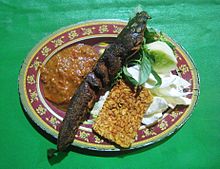 | |
| Alternative names | Pecel lele, pecak lele |
|---|---|
| Course | Main course |
| Place of origin | Indonesia[1] |
| Region or state | Lamongan, East Java province, nationwide in Indonesia and Maritime Southeast Asia |
| Serving temperature | Hot |
| Main ingredients | Clarias catfish served with sambal traditional chili paste |
Pecel lele or pecak lele is an Indonesian deep-fried Clarias catfish dish originating from Lamongan, East Java, Indonesia.[1]
Dish[edit]
It consists of catfish served with traditional sambal chili paste, often served with fried tempeh and/or tofu and steamed rice. It is a popular Javanese dish widely distributed in Indonesian cities, especially in Java. However, it is often associated with Lamongan town, west of Surabaya in East Java, as a majority of pecel lele sellers hail from this town. Often served in a street-side humble tent warung in Indonesian cities, pecel lele can be considered an affordable food for everybody. Today, due to the migration of Javanese people to neighboring countries, pecel lele can also be found in Singapore and Malaysia.
Although it has a similar name, it should not be confused with another Javanese dish, pecel, which is a vegetable dish served in peanut sauce. Pecel lele is not served in peanut sauce, but with sambal terasi (ground chili with shrimp paste sauce) instead. However, some recipes might add a little bit of ground peanuts into their sambals.
See also[edit]
References[edit]
- ^ a b Adi Sucipto Kisswara & Budi Suwarna (24 February 2014). "Sejahtera Bersama Pecel Lele". Warta Kota (in Indonesian). Retrieved 13 January 2015.
External links[edit]
- Pecel Lele recipe (In Indonesian)
Well, that’s interesting to know that Psilotum nudum are known as whisk ferns. Psilotum nudum is the commoner species of the two. While the P. flaccidum is a rare species and is found in the tropical islands. Both the species are usually epiphytic in habit and grow upon tree ferns. These species may also be terrestrial and grow in humus or in the crevices of the rocks.
View the detailed Guide of Psilotum nudum: Detailed Study Of Psilotum Nudum (Whisk Fern), Classification, Anatomy, Reproduction